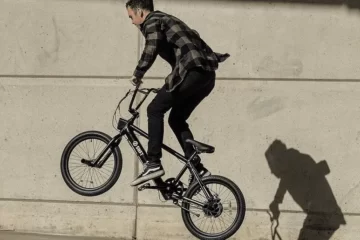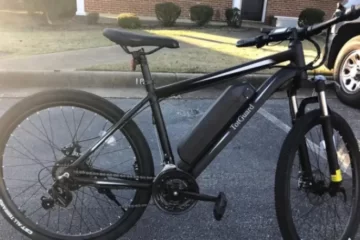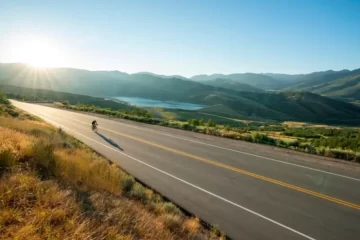Electric bikes, or e-bikes for short, have exploded in popularity in recent years. They’re a fantastic way to get around, offering an eco-friendly and convenient option compared to traditional bikes. But one of the biggest questions for potential e-bikers is: can they really handle hills?
The answer is a resounding yes! E-bikes can definitely conquer hills, but just how steep they can climb depends on a few key factors. Let’s dive into what makes e-bikes great hill climbers and explore some tips to maximize your climbing experience.
E-bike Climbing Power: What Makes the Difference
Imagine an e-bike as a regular bike with a superpower – a little electric motor that kicks in when you need an extra boost. This motor is the key to conquering hills, and its capabilities depend on a few things:
- Motor Power (Wattage): Just like a car engine, e-bike motors come in different wattages. Higher wattage motors provide more assistance, making steeper climbs a breeze. Most e-bikes range from 250 watts to 750 watts, with some reaching over 1000 watts for off-road adventures (be sure to check local regulations for high-powered e-bikes).
- Battery Capacity and Range: The battery is the motor’s fuel tank. A larger capacity battery translates to more power for climbing those hills. Additionally, a higher capacity battery lets you conquer longer and steeper climbs without running out of juice. Remember, batteries lose power over time, so consider battery health when evaluating an e-bike’s climbing ability.
Beyond the Motor: Other Factors Affecting Hill Climbing
While the motor is the star of the show, it’s not the only factor influencing your e-bike’s hill-climbing prowess. Here are some other things to consider:
- Your Weight and the Bike’s Weight: The combined weight of you and your e-bike plays a role. Heavier loads make climbing steeper hills more challenging.
- The Terrain: A paved road is much easier to navigate than a rocky mountain trail. Consider the type of terrain you’ll be riding on most often.
- Your Input: E-bikes aren’t magic carpets – you still need to pedal! The more effort you put in, the easier those climbs will feel.
- Tire Traction and Size: Wider tires with good tread provide better grip, especially on loose surfaces. Larger tires can also give you a mechanical advantage on hills.
- Gears: Just like regular bikes, e-bikes have gears. Lower gears provide more power for climbing, while higher gears are better for flat terrain and speed. Learn how to use your gears effectively to maximize efficiency.
Real-world Scenarios: How Steep Can You Go?
So, how steep of a hill can you actually climb with an e-bike? Let’s look at some real-world examples:
- Gentle Slopes: Even lower-powered e-bikes (around 250 watts) can handle most gentle inclines with ease.
- Moderate Hills: For these, consider an e-bike with a mid-drive motor (generally more powerful) and around 500 watts or more. These are perfect for most everyday hills.
- Steep Hills and Off-Road: If you live in a hilly area or love off-road adventures, a high-wattage e-bike (over 750 watts) with a mid-drive motor might be ideal. Remember to check local regulations for powerful e-bikes.
E-bikes for Every Climb
E-bike manufacturers understand that riders have different needs. Here are some popular e-bike types designed for specific terrains:
- Mountain E-bikes: Built for conquering tough trails, these boast powerful motors, high torque, and rugged components – perfect for steep climbs and challenging terrain.
- Road E-bikes: While not designed for off-roading, they can handle moderate hills. They’re ideal for commuting or paved roads with occasional inclines.
- Cargo E-bikes: These are built to carry heavy loads, including passengers and cargo. Many have powerful motors to handle hills while loaded down.
- Folding E-bikes: Great for city commuting, some folding e-bikes offer enough power for moderate inclines.
Tips to Maximize Your E-bike Hill Climbing
No matter what e-bike you choose, here are some ways to become a hill-climbing pro:
- Use the Right Assistance Level: Most e-bikes have multiple power modes. Choose “Eco” for flat terrain and save battery, and switch to “Turbo” for those challenging climbs.
- Maintain Momentum: Get a little running start before hitting a hill. This makes it easier for the motor to take over and requires less effort.
- Shift Gears Wisely: Use lower gears for steeper climbs. They provide more power to help you push through.
- Monitor Battery Level: Keep an eye on your battery indicator, especially on long rides with lots of climbing. Adjust your assistance level to conserve battery if needed.
- Ride Like a Pro: Simple techniques like keeping your weight forward and maintaining a steady pedaling rhythm can make a big difference in efficiency and power output.
- Choose Your Line Carefully: On trails, anticipate your steering line to avoid losing momentum on climbs.
- Proper Tire Pressure: Inflate your tires to the recommended pressure for your weight and riding conditions. This improves traction and efficiency.
- Right Tires for the Right Ride: Choose wider tires with aggressive tread patterns for off-roading and trails, and narrower tires for smoother surfaces.
The Takeaway: E-bikes Conquer Hills
Electric bikes are a fantastic way to experience the joy of cycling without worrying about hills. By considering the factors mentioned above and choosing the right e-bike for your needs, you can conquer hills with ease and open up a world of possibilities on your rides. So, ditch the fear of those steep climbs and get ready to explore further with the power of e-bikes!




